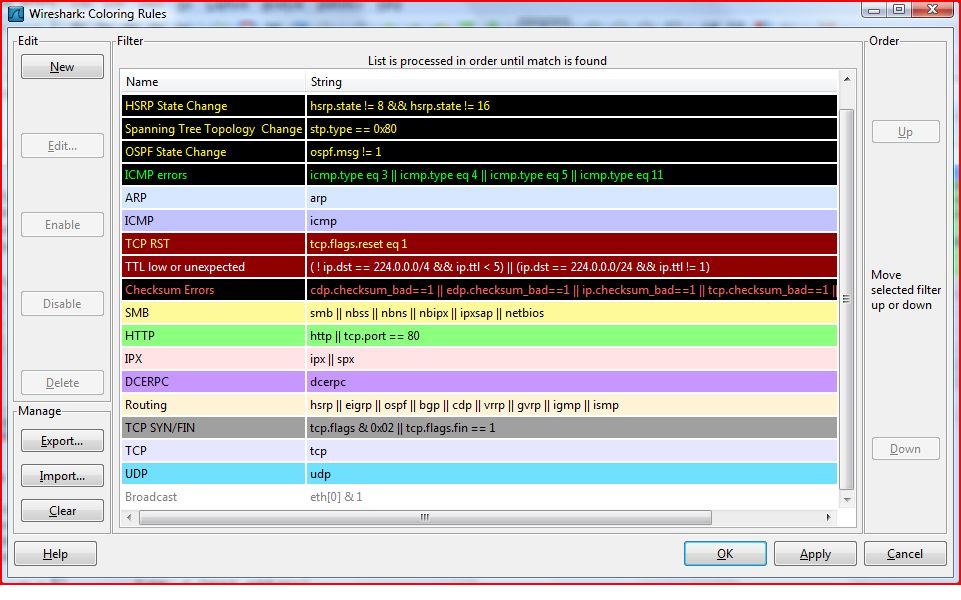
To check if promiscuous mode is enabled, click Capture > Options and verify the “Enable promiscuous mode on all interfaces” checkbox is activated at the bottom of this window. If you have promiscuous mode enabled-it’s enabled by default-you’ll also see all the other packets on the network instead of only packets addressed to your network adapter. Wireshark captures each packet sent to or from your system. You can configure advanced features by clicking Capture > Options, but this isn’t necessary for now.Īs soon as you click the interface’s name, you’ll see the packets start to appear in real time. What is color coding in Wireshark The packets in the Wireshark are highlighted with blue, black, and green color. For example, if you want to capture traffic on your wireless network, click your wireless interface. Capturing PacketsĪfter downloading and installing Wireshark, you can launch it and double-click the name of a network interface under Capture to start capturing packets on that interface. Don’t use this tool at work unless you have permission. We also provide you with a PDF file that has color images of the screenshots/. But it can be fairly accurate.įor the Wireshark introduction, you can read my blog on Wireshark installation and how to use it here.Just a quick warning: Many organizations don’t allow Wireshark and similar tools on their networks. using Wireshark, basic Python code, and tools that complement Wireshark. By default, green is TCP traffic, dark blue is DNS traffic, light blue is UDP. We know that IPv4 addresses can be easily spoofed, you can’t rely completely on this geographical information. Wireshark uses colors to help you identify the types of traffic at a glance. If you click on the Map button at the bottom of the screen (shown in Figure 9 above), Wireshark will show you a map, providing its best guess of the location of the IP addresses you’ve identified. In some cases, it is even possible to use Wireshark to identify the geographic location of the source and destination traffic. Wireshark tries to help you identify packet. Chercher les emplois correspondant à Wireshark color codes ou embaucher sur le plus grand marché de freelance au monde avec plus de 21 millions demplois. Now that you have some packets, its time to figure out what they mean. If you go to Statistics and then select Conversations, you will see a summary of conversations between endpoints, as shown below: What the Color Coding Means in Wireshark. It’s also possible to capture the amount of traffic generated between one system and another.

Many times, cybersecurity pros use Wireshark as a quick and dirty way to identify traffic bursts during attacks. In this case, three major traffic bursts were generated. Chapter 5 Color Codes 5.1 Getting Started 5.2 Creating Color Code Lists 5.3 Adding and Removing Filters 5.4 Other Coloring Options 5. The spikes in the graph are bursts of traffic that were caused by generating a Distributed Denial of Service (DDoS) attack using a few Linux systems. The above graph is showing typical traffic generated by a home office. For this in Wireshark, just go to statistics > I/O graph, and there we can see a graph like shown below: It is also possible to view the input/output statistics of an entire packet capture.

In Wireshark, we are not limited to just interpreting packets by colors. It’s possible, even, to colorize specific conversations between computers. It’s a toggle, so if you want the coloring back, simply go back and click Colorize Packet List again. If you don’t want any coloring at all, go to View, then click Colorize Packet List. This option can be repeated multiple times, of course. A UTF-8 string of a color filter rule to apply, in Wireshark color filter syntax. Example: 'http & tcp.port 8080' 3: Color filter.

We can even change the defaults or apply a custom rule. A UTF-8 string of the display filter that was used to limit the entries in the file, in Wireshark display filter syntax. You can view this by going to View > Coloring Rules. The default coloring scheme is shown below figure. Windows-specific traffic, including Server Message Blocks (SMB) and NetBIOS So Wireshark tries to help you identify packet types by applying common-sense color coding. Now we’ll go a bit more deep into Wireshark and see how to read the captured packets. If you want to see the different types of protocols Wireshark supports and their filter names, select. The local IP addresses should appear at the top of the list. You’ll see both the remote and local IP addresses associated with the BitTorrent traffic.

In my previous blog, I explained Wireshark, Its installation, and how to use it. Click over to the IPv4 tab and enable the Limit to display filter check box.


 0 kommentar(er)
0 kommentar(er)
